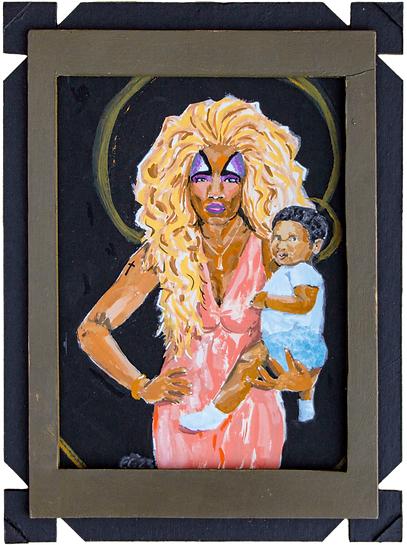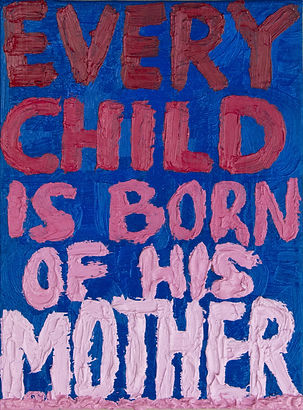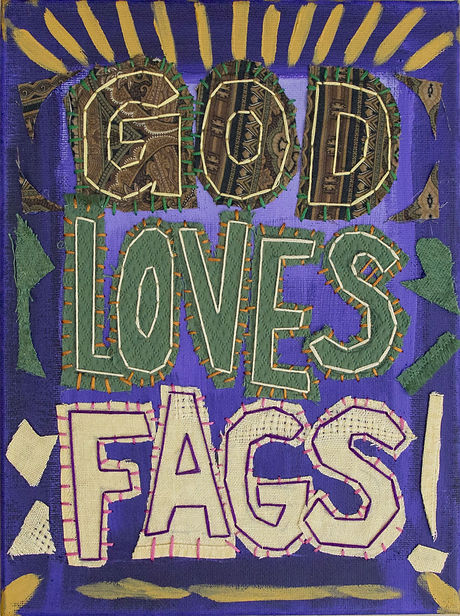top of page
Transdivinity
A Senior Thesis Exhibition
December 6-9, 2023
Montserrat College of Art
TRANSDIVINITY is a recontextualization of ideals that have historically been used as tools of oppression. The work explores queerness and transness in a Christian-centric religious context, drawing parallels between suffering and salvation, pain and pleasure, and identity and belief. Religious iconography and references to famous Christianity-based art are highlighted throughout, as well as symbolism reflecting trans bodies and identities.
jump to:

Transdivinity Zine
This handmade risograph & photocopier zine compiles every piece in the Transdivinity series so far and provides insight and explanation into the artists' thoughts while making. Includes a resource list, typographic samples, and handwritten notes throughout.
Interested in a handbound print copy? Get in touch!

Transdivinity Stickers
Three sticker designs based on Transdivinity's typography.
Interested? Get in touch!

“Creation of Self” is an oil painting directly inspired by Michelangelo’s “The Creation of Adam” (1508-1512), a central panel of the Sistine Chapel’s ceiling. Michelangelo’s original piece depicts the moment that God gave life to man (Adam) as outlined in Genesis. This was the very first piece I created for Transdivinity. With it, I explored the idea of transition as an act of divine creation. I have personally found transition to be a very holy and beautiful process. As I have come into myself through transition, I have learned what it feels like to truly love yourself and find that you feel at home in your physical body. This is the parallel that I drew between transition and God’s creation of man. In my piece, the two identical figures are visibly trans, with top surgery (double mastectomy) scars and female genitalia. The text reads “TO BE TRANSSEXUAL IS TO BE CLOSE TO GOD”.


The motif of a Madonna and Child is incredibly common within Christian art, particularly during the Renaissance, which is where I focused most of my art history research. Compositionally, each iteration I came across was very similar, with the haloed Virgin Mary centered in a rectangular or arched frame with Baby Jesus in her arms or lap. People also frequently use very small (under 12 inches in any direction) Madonna and Child portraits for personal worship in their homes.
For my take on this idea, I kept with the theme of motherhood. My pieces depict drag queens with their children. An especially prominent (and exceptionally false) ideal that many Americans hold is that drag queens and kings are in some way a danger to children. This view evolved from the same belief about gay people and trans people. In recent years there have been many legislative “drag bans” across the country in an attempt to stomp out this beautiful art form. With my work, I want to immortalize these queens and their real-life stories in the same style as a cherished Madonna and Child painting. Each piece depicts a performer in full drag (wig, makeup, and costume), each holding a child the same way the Virgin Mary held Baby Jesus. The small sizes allow a level of intimacy between the work and its viewer and allude back to the idea of domestic and personal devotion.



Referenced Works
Madonna and Child, Giovanni Bellini, c. late 1480s
Madonna and Child, workshop of Giovanni Bellini, c. 1510
Madonna and Child, Andrea del Sarto, c. 1530

This piece was one of my first experiments with combining fiber art and painting. I sewed and embroidered fabric onto a painted stretched canvas to form the words GOD LOVES FAGS. I enjoy the handmade appearance I have achieved in all my work, but I especially enjoy it in this piece.

“The Arnolfini Portrait” is a 1434 oil painting by Jan van Eyck. The identities of the couple are not officially confirmed, but the piece is speculated to have been done as a documentation of a marriage between the wealthy merchant Giovanni Arnolfini and his wife. The original piece focuses on strictly the legal aspect of this union (as well as the inherent promise of offspring from the woman), and there are symbols of fertility and Christianity scattered throughout (prayer beads, Biblical illustrations on the mirror, and fruit on the windowsill).
With my iteration of this famous painting, I focused on a marriage of love and connection between two trans individuals. The institution of marriage is heavily rooted in religion and heteronormativity, and many queer people find that for them it only serves a legal or financial purpose. I believe this was the intent of van Eyck’s original portrait, but I believe that two people should be together out of affection for one another, not finances or procreation. In addition, trans love is special because of each party’s ability to understand the other on such a core and fundamental level as gender. The term is trans4trans, or T4T: trans people who date other trans people. This theme is also echoed in Red Collage 1.

Arnolfini Portrait Detail

Arnolfini Portrait Detail

Arnolfini Portrait Detail

Arnolfini Portrait Detail
1/5
(above) Arnolfini Portrait, Jan van Eyck, oil on wood, 1434
(left) Detail shots

The Holy Cross hints at a couple of less-represented but still critical notions that tie into my overall theme: the prevalence of older queer and trans people and the LGBTQ+ leather subculture. It is rare especially outside of big cities like New York and San Francisco to encounter queer people over the age of fifty. Sadly, the HIV/AIDS epidemic claimed many queer lives before they had the chance to grow old. Today, it is important to listen to and learn from the queer and trans elders in the community and ensure their stories do not disappear. I chose to depict someone older in order to provide that representation.
The leather subculture within the LGBTQ+ community originated in post-WWII biker culture, when many gay men, after leaving the military, rejected the nuclear family lifestyle and formed motorcycle groups. Today, the leather community is a major part of the kink and fetish world as well as simply being a lifestyle for many. In some groups, there are traditions and ranks similar to the structure of the military. Though it is certainly not exclusive, leather is commonly associated with masculinity, and many participants get involved because it is opposite to a lot of stereotypes about gay men. Some examples of media that involve the leather community are the 1980 Al Pacino film Cruising (though this film does not necessarily document the community in a positive manner) and the art of Tom of Finland. Additionally, a major event in the leather and fetish community is the annual Folsom Street Fair in San Francisco, where people come together to celebrate and showcase kink culture.

Out of all the pieces created in my series thus far, BLEED BY THY HOLY WOUND was the most visceral. It is an exploration of the idea of needing to suffer in order to achieve something higher than yourself. The image of a crucifix is associated primarily with pain and sacrifice, and with my piece, I wanted to illustrate the reclamation of that pain. Though gender-affirming surgery is obviously a physically painful procedure, it is a small sacrifice to make for a lifetime free of dysphoria. BLEED BY THY HOLY WOUND began as a vaguely cross-shaped piece of cardboard. I affixed receipts and scraps of mailing labels to it to emphasize the crucifix shape and began to outline a skeleton in watercolor. The strips of newspaper on the lower half are upside-down columns from the obituary section, and the receipts are from my own purchases. Afterward, I outlined the figure in ink and created a sunburst halo shape around the head. Lastly, I stenciled the text using tracing paper and splattered the whole piece with drops of watercolor.

The text “Trans by the hand of God” refers to the idea that God did not create man to be only male and female: He created us to be ourselves and that is just as natural and worth identifying with as any cis identity. This is another embroidered piece on stretched canvas; I enjoyed experimenting with different effects for the text as well as viscerally scribbling with oil pastels.



Red Collage 1 - Detail

Red Collage 1 - Detail

Red Collage 2 - Detail

Red Collage 1 - Detail
1/7
This collage as well as Red Collage 2 were almost entirely accidental. I was shuffling through the old reference images I had printed out, hoping to repurpose them in some way, and I came across some red and black scrap paper in a storage drawer in the studios marked “FREE”. And to be quite honest, most of the shapes in these collages came from dropping the scrap paper and it haphazardly falling on top of the red paper in interesting ways.
Thematically, for Red Collage 1, I decided to revisit a theme I had explored in my Arnolfini Portrait piece - T4T relationships. I scribbled in chalk pastel over a printout of Jan van Eyck’s original painting that I had used to reference for my version. I also cut scraps out of the Creation of Adam and Andrea del Sarto’s 1530 version of Madonna and Child and drew doodles all around the piece. The text - “Warmth is Power” - alludes to the idea that trans joy is resistance. Trans people being happy and prideful in themselves and their identities is in itself a form of opposition to cisheteronormative standards of happiness (heterosexual marriage, kids, white picket fence, the whole nine yards).
Red Collage 2 draws connections between the Creation of Adam and the Madonna and Child motifs. Both stories involve creation - either the creation of Man or a mother’s creation of a child. I wanted to acknowledge that self-creation cannot exist without parental creation first, though after that deed is done it is often up to the child to figure themselves out alone.
I took a similar process to this piece as I did with Red Collage 1 where the composition was mostly left to chance. I included some text clipped from my first-semester process book as well as a Bible verse: Proverbs 31:28 - “Her children rise up and call her blessed”. Trans people often have very complicated relationships with their parents, and I wanted to convey that mixed message in this collage.

Saint Sebastian was a Christian saint known for his martyrdom and death at the hands of the Romans around 250-300 AD. It is believed that he was killed during the Diocletianic Persecution of Christians, which was the last and most violent movement against Christians by the Roman Empire. Sebastian is said to have been sentenced to death, but the initial attempt with arrows did not kill him. Tradition states that he was rescued and tended to by Saint Irene of Rome. Once healed, despite his brush with death, he revisited Rome to continue spreading his message and was subsequently clubbed to death.
He has been a popular artistic subject throughout history, being commonly depicted as a scantily-clad attractive young man, tied to a tree and penetrated by half a dozen Roman arrows. His facial expression is almost always one of neutrality or even somber joy. It is not surprising that queer artists have picked up on the homoeroticism within his imagery and story. There are plenty of iterations of the Saint Sebastian motif in just about every medium you can imagine. Some of my favorites include Alexander Kosolapov’s 1980 photographs titled St. Sebastian and Euan Uglow’s Saint Sebastian oil painting. His story is also the central plot of Sebastiane, a 1976 experimental erotic film (which can be viewed for free here).
My Saint Sebastian-inspired work takes another adjacent angle to the idea of suffering to achieve salvation and making sacrifices for what you believe in. The imagery depicts a figure, bound at the arms and wrists, who has been shot with golden arrows across their chest. The red, gold, and pink beads form the shape of top surgery (double mastectomy) scars, a surgical procedure that trans people frequently get. The piece’s text, which reads “could mutilation not also be mercy?” points a finger at individuals claiming that trans people are “mutilating” our bodies by going through hormone replacement therapy, cosmetic surgery, and other gender-affirming procedures. These actions are less of a choice and more of a necessity. We do not do it because we want to; we do it because we cannot survive any other way. I find parallels between this theme and Saint Sebastian’s story, or that of any martyr. Being willing to undergo physical pain and alteration in order to align your life with what you believe in is a brave and necessary act.


Referenced Works
Still from Sebastiane, a 1976 experimental erotic film
Saint Sebastian, Euan Uglow, oil on panel

These pieces explore the experience of pain being pleasure and the BDSM scene, which is a huge part of the LGBTQ+ community’s present, future, and past. It ties into the leather community and my notes on page 15. The element of embroidery and stitching acts as a nod to both ropework/erotic bondage as well as surgical sutures and stitches. It may also invoke the shapes of self-harm scars. It is, of course, up to personal interpretation.

bottom of page









